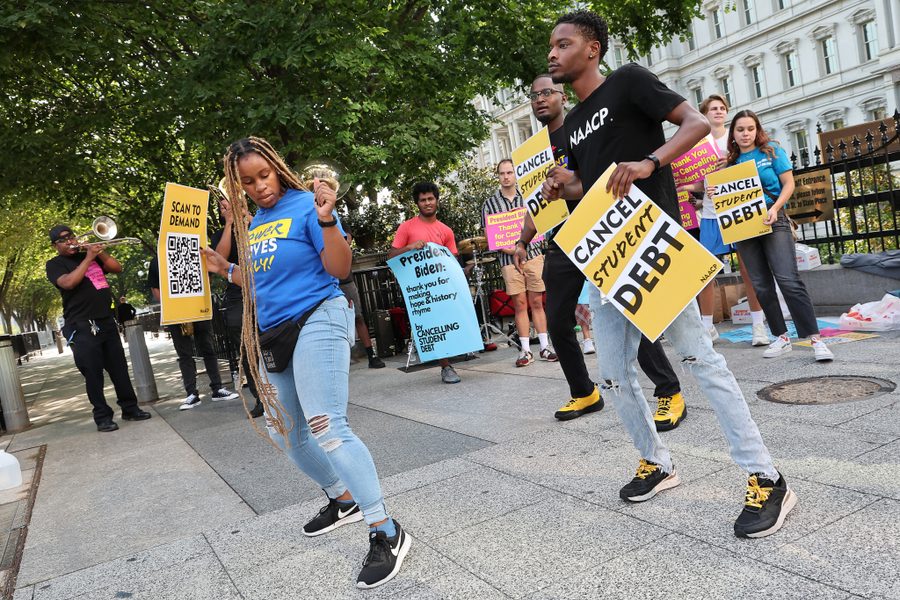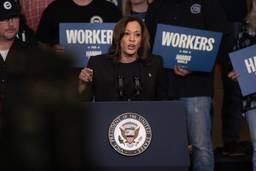Biden’s Student Debt Relief Plan Is a Very Good Economic Policy
The critics are wrong—cancelling student debt will actually help ease inflation and benefit working-class borrowers.
Max B. Sawicky

On August 24, the Biden White House announced its plan to provide relief for Americans carrying student debt. The amount of debt cancellation may be as much as $20,000 for Pell Grant recipients, and otherwise $10,000, in either case for individuals with annual incomes under $125,000 and married couples earning less than $250,000. There are other features of the plan that will help alleviate the debt burden — such as a 5 percent cap on payments of loans in relation to monthly incomes — but those are the headline numbers.
Let’s roll through the arguments for and against relief. This is an intra-Democratic Party debate as much as a partisan one. You can guess where the Republican Party is on this — wholeheartedly opposed to the idea of debt cancellation. No ambiguity there. But in the case of Democrats, we have serious people on both sides. The criticisms don’t hold water, and the policy should be welcome.
Nothing substantial is likely happening in Congress for the remainder of this year, meaning that further major policy change depends on executive action by the White House. The legal boundaries for President Biden’s scope of action have been in dispute, so the new debt relief plan could get tangled up in legal challenges.
During his election campaign, Biden committed to at least $10,000 of relief, disappointing those who wanted more. Calls for higher levels are daunting for an administration that is spooked by the ongoing inflation spike. The threat of inflation is contested, but there is no question that the price increases of the past year have yet to settle down. This seems to be the favorite whipping boy for the Republicans, though its power in the face of other worries by voters, such as the potential of an authoritarian turn of the federal government, may be doubted.
The cost of debt relief is easily misunderstood. We get topline numbers of the total cost, maybe $300 billion, but the entire amount would not have an immediate impact on consumer spending, and therefore no immediate effect on the price level. Rather, as every borrower knows, their debt payments are spread out over years, if not decades. The inflation impact depends on the extent to which savings in monthly payments are channeled into consumer spending.
The Biden administration has maintained a moratorium on student debt repayments since it took office. Its plan calls for restarting payments in January 2023. Since those payments, even when reduced by the new relief, reduce the current spending power of debt holders, the impact of the debt cancellation policy is not inflationary, but precisely the opposite, whenever the pause in payments due to the pandemic ends, as economists Paul Krugman and Dean Baker have pointed out. In the context of the current economy and current policy (including the pandemic “pause” in payments), the debt relief policy is deflationary in the longer term. Since the administration is also extending the pause until the end of 2022, over the next four months, there could actually be a positive effect on price levels. How much?
Suppose the plan leads to $300 billion in relief, as many outlets are projecting. If required payments resume next year, the positive inflation impact is limited to the next four months. What is the inflationary impact of an extra $10 billion ($300 billion spread over ten years prorated to four months) in extra spending, compared to total personal consumption spending of $4.25 trillion in the second quarter of this year? Not much. Here the inflation fear belongs in laugh test territory.
Using economic modeling rather than just a calculator, economists at the Levy Economics Institute of Bard College found evidence for a similarly limited impact on inflation if the government was to cancel the entirety of student debt (now at $1.6 trillion), and their analysis from 2018 includes no account of any payment pause. In the models, debt relief provides a Keynesian boost to employment and includes a variety of added social benefits, but that study was done four years ago. The likelihood of a bump in GDP in the wake of this year’s spectacular job growth is diminished, compared to 2018.
Perhaps envy is the feeling that comes up most often in the debt relief debate, with opponents claiming some version of “I paid my debt, it’s not fair for somebody else to get a break.” This is very personal for both sides — those who paid and those trying to pay — and hence it’s politically important. But it’s foolish from a policy standpoint. Any reform could help somebody while failing to help somebody else for whom the remedy no longer applies. Is it fair to provide a benefit to a person that somebody in the past failed to receive, because there was no program to provide that benefit? By that line of thinking, no reforms would ever be tenable.
Another common complaint is that Joe Sixpack will pay the student debt of some Ivy League, big-shot attorney. It doesn’t work that way. Nobody is paying off anybody else’s loans. Nobody’s tax dollars are earmarked to some mythical “loan pay-off” account. Taxes next year depend on total federal spending, the state of the economy, and more frivolous factors. It is true that “other things equal,” the cost of the Biden plan is reflected in total spending, paid for by borrowing or taxes. But other things are never equal, so the impact of the plan on your taxes is utterly unknowable.
The bigger dilemma, envy aside, is that relief for existing borrowers does nothing to resolve the problem of costs for future students. Schools might be tempted to increase tuition, knowing that some of their current students’ ability to borrow is increased after the windfall from debt relief. “You got $10,000 in relief, so you can borrow another $10,000.” A pressure in the other direction is that higher tuition discourages new students from entering higher education with no certain prospect of relief in the future.
The politics of envy are complicated somewhat by confusion over debt relief for the rich. The value of “means-testing” is said to be budget savings, but essentially every analysis indicates that the budget savings from excluding very wealthy families from any benefit are minimal. The big dollar savings are with the broad upper-middle class.
The relief forthcoming will be limited to individuals with incomes up to $125,000, and families below $250,000. These amounts are well above median levels, but they still expose many higher-income families to continued liabilities. Not surprisingly, in dollar terms, most debt is held by those with higher incomes, since one’s ability to borrow in the first place hinges on income. So these income limits should indeed reduce the cost of the program significantly.
Opposition to means-testing is often justified by reference to the administrative costs of distinguishing among those eligible and ineligible. Administrative cost, however, is a function of investment in administration. The increase in funding for the Internal Revenue Service passed through the Inflation Reduction Act will help. In general, the long-term shrinkage of the federal civil service outside of defense and homeland security makes it more difficult to run every sort of program. This problem is bigger than student debt.
There are frequent claims from some entranced by Modern Monetary Theory that budget costs are meaningless because spending power, for all practical purposes, is able to shoulder very broad debt relief. I would agree that, in economic terms, there is room for much greater relief — but the political constraint remains. Short of the general public being converted to an MMT point of view, there remains a political limit to the extent of debt relief, albeit disguised as an aversion to providing relief to “the rich.”
Analysis of the distributional impact of debt relief—the impact on income inequality — is tricky. It depends on what you’re comparing to what. A simple take is that the $10,000 cap on relief will still help many middle- and working-class Americans in percentage terms (the increase in spendable cash compared to their incomes). For the rich, if they were eligible, it would be a drop in the bucket. There is also an impact of reducing the racial wealth gap.
We are bound to see criticism of any policy in the form of “The money we are wasting on debt relief for the rich could buy millions of hamburgers for the homeless.” Of course, these same critical parties would likely object to the latter option for one reason or another. The truth is that such an alternative is not currently on the table, nor will the debt relief policy, once it’s in the can, constitute any constraint on fiscal policy under the next Congress. The comparison is meaningless.
Even after debt relief is carried out, the overarching appeal of Bernie Sanders’ plan for free college will remain, so long as tuition costs remain exorbitantly high. The inflation impact of greater amounts of relief is typically exaggerated. A lot more would not be bad.
Max B. Sawicky is an economist and writer in Virginia, formerly with the Government Accountability Office and the Economic Policy Institute. He is a Senior Research Fellow at the Center for Economic and Policy Research and runs the MaxSpeak, You Listen! blog at sawicky.substack.com.








